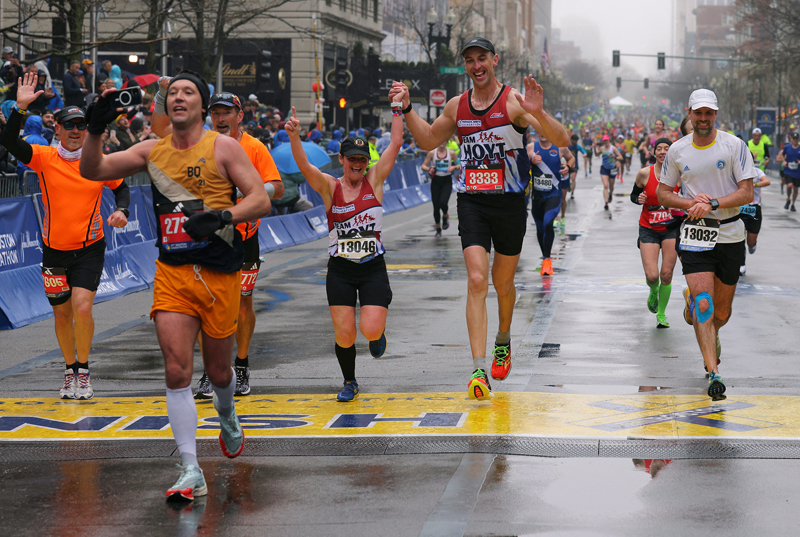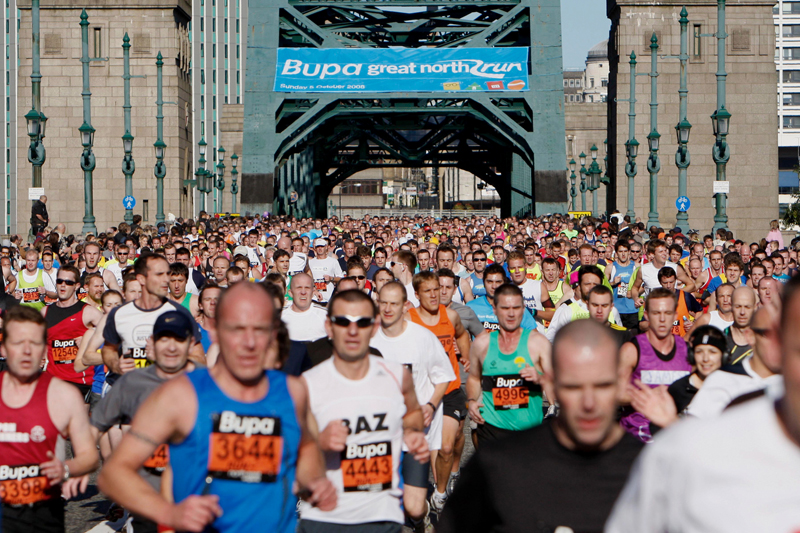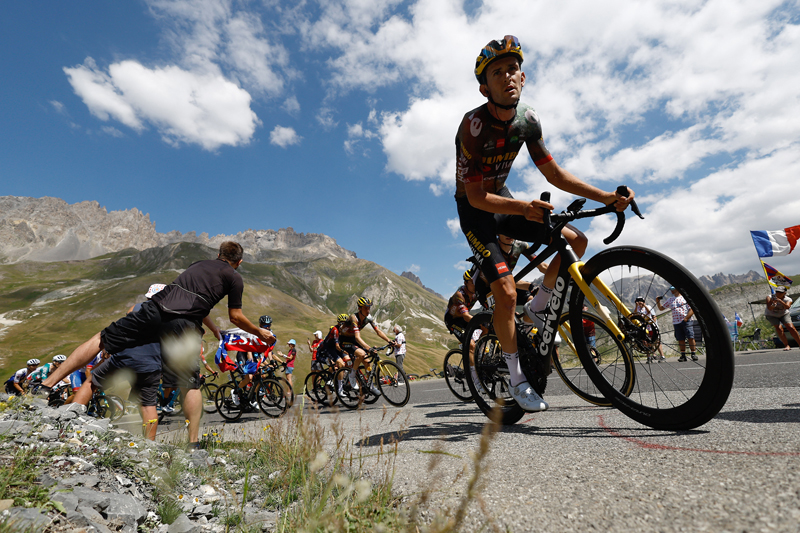Ergogenic Aids: can increasing oxygen levels improve sports performance?
When supplementation with oxygen really helps performance
In the last issue of this newsletter, I effectively demolished the idea that oxygen supplementation before or after exertion might be beneficial to athletes. As I pointed out, taking in extra O2 might theoretically be helpful just before a competitive effort, except that athletes would have to hold their breaths for a rather extended period – from the time they took their last draught of oxygen until their events actually began. Such breath-holding is impractical if not downright impossible. Furthermore, no well-controlled scientific study has ever linked pre-exercise oxygen supplementation with significant improvements in performance. When you see an athlete with an oxygen mask over his or her face just before entering a competition, you can rest assured that the practice will have as beneficial an effect on performance as rain-dancing!While it might seem logical that post-exercise oxygen would boost the recovery process (by spurring metabolism and potentially enhancing the synthesis of valuable chemical compounds within muscle cells), there is no evidence in favour of this supposition either. In fact, the post-exercise period is ordinarily marked by submaximal heart rates and modest rates of oxygen delivery to tissues which have been involved in the workout. In other words, there is not a high demand for oxygen during recovery; if there were such a demand, the heart would willingly kick more blood and oxygen in the direction of the muscles, and supplementation would be unnecessary.
There is one situation, however, in which sports-related oxygen supplementation is very helpful – and that is during exercise. A plethora of scientific research suggests that athletes can exercise longer and more intensely when they breathe in extra oxygen during their exertions.
The rationale for oxygen supplementation during exercise is derived from the knowledge that during intense exercise, the rate of supply of oxygen to working muscles does not satisfy the demand. By breathing in supplementary oxygen, an athlete could, hypothetically, saturate his blood more fully with O2 and thus supply the desired oxygen without actually increasing blood flow or heart rate (both of which might, in any case, be ‘maxed out’ during intense exercise).
If you are an oxygen-supplementation sceptic, you might at this point be asking that short but often critical question: ‘So?’ As you are undoubtedly aware, even if taking in additional oxygen during exercise did boost performance, it is hard to imagine football players running around the pitch with oxygen tanks strapped to their backs or swimmers tethered with oxygen tubes.
These are fair points, but the basic idea would, of course, be to use oxygen during training rather than competition. An athlete might, for example, train in an environmentally-controlled room with an oxygen-enriched atmosphere; alternatively, it is not impossible to conceive of someone working away on a stationary exercise device like a treadmill or cycle ergometer while wearing a tight-fitting mask connected to an oxygen-supplying device – only slightly more intrusive than headphones! The additional oxygen could enhance the quality of the workout, which would undoubtedly be beneficial: competitive fitness is, after all, an attribute that is built up slowly but steadily over time through high-quality training sessions.
Increased blood oxygen content is balanced by decreased flow
There is one oxygen-related problem which must still be surmounted, however: although the basic ‘meet the muscles’ demands’ rationale for using oxygen during training seems unarguable, it has not stood up well to scientific scrutiny. In fact, one well-conducted investigation found that, although the breathing of hyperoxic gas mixtures did indeed increase the oxygen content of arterial blood, this process was perfectly balanced by a decrease in blood flow to the working muscles – so that the actual amount of oxygen delivered to the muscles remained exactly the same(1). Through physiological feedback mechanisms, the muscles seemed to be saying: ‘Thanks! The blood you are sending me is richer now, so I don’t need quite so much of it. Let some other part of the body use some of the red stuff I’ve been consuming up until now’.
Nonetheless, VO2max (the maximal rate of oxygen consumption) does increase by 2-5% when athletes exercise in a hyperoxic environment, and performances improve by up to 40% when athletes breathe pure 100% oxygen instead of the standard 21% oxygen air (2). How can these findings be reconciled with the fact that there is no actual difference in oxygen delivery to muscles?
There are various possibilities, but it is clear that increased availability of oxygen decreases pulmonary ventilation (the movement of air in and out of the lungs) and thus reduces the muscular work required for breathing(3), an effect which could lead to a significant improvement in athletic performance. In one study, nine well-trained individuals ran to exhaustion on a treadmill on five different occasions, while breathing in one of five different gas mixtures – 20%, 40%, 60%, 80% and 100% oxygen. In all five cases, the running speed selected for the treadmill exertion was exactly 10% faster than the velocity required to elicit VO2max(4). For many runners, this would be comparable to an all-out 1,500m running tempo.
The five bouts of exercise were scheduled one week apart to minimise the effects of post-test fatigue, and the athletes were ‘blinded’ to the gas mixtures they were breathing in – and even their actual running times. The results showed clearly that as oxygen concentration rose above 60%, running time at 110% vVO2max also increased, with 80% better than 60% and 100% better than 80% in terms of fatigue-resistance. Notably, ventilation decreased in line with increased oxygen concentration, and the decrease was a function of decreased breathing frequency, not the amount of air exchanged per breath.
In a unique follow-up study(3), ten athletes ran to exhaustion on a treadmill while breathing in one of four gas mixtures:
20% oxygen and 80% nitrogen (very similar to ‘normal’ air);
20% oxygen and 80% helium;
80% oxygen and 20% nitrogen;
80% oxygen and 20% helium.
In this investigation, performance times increased significantly under hyperoxic conditions (conditions 3&4), but they also improved appreciably whenever helium was ‘in the mix’ (2&4). How should we interpret these findings?
As it turned out, the mass of air moved in and out of the lungs was less whenever helium – rather than nitrogen – was combined with oxygen (remember that helium is considerably lighter than nitrogen), and thus the work performed by the respiratory muscles was considerably less. In addition, the work carried out by the muscles was lower whenever oxygen levels were elevated, as if the respiratory muscles realised they did not have to make such strenuous efforts to pull oxygen in from the atmosphere. A reasonable broad conclusion is that performance rises whenever the load on the respiratory muscles is reduced. There are two possible reasons for this:
1. Perceived effort – the level of difficulty an athlete consciously assigns to a specific type or intensity of exercise – depends on a variety of physiological cues, including the degree of stress experienced by the respiratory system during the conduct of the exercise. If this respiratory stress is lightened, the intensity of exercise is felt to be lower, and an athlete will usually have confidence that he or she can perform at the given intensity for a longer period of time; 2. A reduced respiratory workload translates into a lower whole-body demand for oxygen during exercise (don’t forget that the respiratory muscles require oxygen during exercise too). Since the oxygen cost of exercise is reduced, an athlete will be operating at a lower fraction of VO2max and thus the duration of exercise can be increased, there being a direct inverse relationship between exercise sustainability and %VO2max.
The risk of haemoglobin desaturation
There is one other key reason why oxygen supplementation can work. Interestingly enough, some athletes who are able to sustain exercise at very high intensities experience ‘desaturation’ of their haemoglobin (ie, the amount of oxygen bound to haemoglobin declines) when they work very strenuously under normoxic conditions; (remember that haemoglobin is the red blood cell compound that actually ‘carries’ oxygen through the blood). In theory, these accomplished athletes might benefit from breathing in high-oxygen gas mixtures as they train at very high intensities, since, under such conditions, it would be less likely that their haemoglobin would become desaturated with O2, and thus oxygen could be supplied at higher rates to working muscles.
To check out this possibility, researchers at the University of Florida divided 20 healthy male athletes into two groups:
a ‘trained’ group of 13, with an average VO2max of 56.5 ml/(kg-min);
a ‘highly trained’ group of seven with an average VO2max of 70.1 ml/(kg-min).
Members of the latter group were known to experience exercise-related haemoglobin desaturation, which was defined as a condition in which the percentage of oxygen bound to haemoglobin fell to 92% or below (the ‘normal’ or resting value being about 97%).
Athletes in both groups performed two incremental cycle ergometer tests at sea level to determine VO2max(5); one test was completed under normoxic conditions (at 21% oxygen) and the other in a slightly hyperoxic situation (26% oxygen). As it turned out, the percentage of oxygen bound to haemoglobin during maximal exercise was significantly higher for both groups under hyperoxic conditions. However, the highly trained group was able to elevate VO2max from 70.1 to 74.7 under hyperoxic conditions, while the trained group were unable to raise VO2max. Thus, it seems clear that pulmonary gas exchange can contribute significantly to limitation in the maximal aerobic capacities of highly trained athletes.
The benefits of oxygen supplementation for workout quality became apparent in research carried out at the University of New Mexico several years ago(6). Initially, the athletes involved in the study trained in a very basic way: they spent about two fifths of each training session working at a modest intensity of 50% of their maximal work load (defined as the highest work rate – in watts – which the cyclists could sustain for at least 30 seconds). Heart rates probably reached 50-60% of maximal during these light efforts.
During the remainder of each workout, however, the athletes trained at a fairly demanding intensity of 85% of maximal work load, which produced heart rates of around 90-95% of maximal. The cyclists continued training in this manner for several weeks, until their performances reached a plateau beyond which no further improvements in endurance were attained. With considerable variation between athletes, it took between seven and 35(!) weeks to reach this plateau.
After reaching their plateaus, the athletes tried to step up their workout quality by alternating three-minute work intervals at 95% of maximal work load (instead of the previous 85%) with two-minute recovery intervals at 50% of maximum. However, the 95% intensity proved so tough that it was impossible for the cyclists to complete a full 40-minute workout. In fact, the best they could do was cycle for a total of about ten minutes – just two work intervals and two recoveries!
How added oxygen helped cyclists complete a tough workout
To make it possible for the cyclists to complete a full workout at the seemingly unattainable 95% intensity, the researchers allowed them to breathe an air mixture containing 70% oxygen as they exercised (remember that the oxygen concentration of ‘normal’ air is 21%, unless you happen to live in London, New York or Los Angeles, where oxygenated air is slightly more elusive). With the added oxygen, the cyclists were suddenly able to complete the higher-intensity 40-minute workouts (made up of eight work intervals and eight recoveries), and they carried out a rather incredible total of four per week over a six-week period!
Note that this is exactly the kind of situation in which you would expect oxygen supplementation to be beneficial. The athletes were experienced and they were working at close-to-maximal levels during their workouts. Thus, their haemoglobin was likely to be desaturated, a situation which the supplemental oxygen could at least partially correct. Voila! The better oxygen supply to muscles allowed exercise to continue longer at the chosen red-hot intensity. Undoubtedly, the added oxygen also decreased respiratory-muscle work and made the intense efforts feel a bit easier.
You will be glad to hear that the six weeks of hyperoxic work also improved the athletes’ performances considerably (after all, what good are hard workouts unless they actually lead to better physical outcomes?) The athletes’ endurance levels while pedalling at 85% of max workload (90-95% of max heart rate) increased by 32% (!) after six weeks, and heart rate during high-intensity cycling declined by around five beats per minute. Crucially, the athletes achieved their gains without having to spend more time training; they worked out at the same frequency and duration as they had done before the six-week hyperoxic-training period. The only change was the increase of interval intensity from 85 to 95% of maximal, which was made possible only with the use of supplemental oxygen.
The New Mexico scientists speculated that – among other things – the hyperoxic training may have boosted the blood volumes of the athletes. A rise in blood volume is one of the key adaptations to endurance training, and intensity – not the number of workouts per week or the total duration of workouts – is its most potent trigger; that’s because high-intensity workouts stimulate special tubules within the kidneys to hold onto more plasma, thus thwarting the kidneys’ perverse desire to literally waste fitness. The resultant increased quantity of blood permits more red fluid to reach athletes’ muscles during exercise. More blood means the muscles get more oxygen, and more oxygen translates into greater energy production and improved performance.
So what are your bottom-line ‘oxygen lessons’? Obviously, you shouldn’t bother going to altitude to train in the hope of improving your performances. High-altitude locations are nice places to live, because of the great views and the clean air – and also because the decreased oxygen pressures associated with altitude can really boost your blood haemoglobin levels. Unfortunately, however, the reduced oxygen pressures associated with altitude decrease the quality of training sessions and thus hamper sea-level fitness. To put it another way, it is very difficult to develop the ability to move faster when you are always moving more slowly during your training.
Rather than looking for a low-oxygen environment, you should jump at any chance you have to train under high-oxygen conditions, which will enable you to work at faster-than-usual speeds that can be sustained for unusually long periods. This kind of training will make you fitter, even in normoxic environments. In short, high-oxygen exercise can really gas up your training sessions – and thus your ultimate performances.
As the Florida research suggests, such training will be particularly valuable to highly-trained athletes, the ones who can really crank up training intensity and sustain high intensities for long enough to desaturate their haemoglobin. Currently, most such athletes think ‘altitude’ when it comes to fundamental alterations in training, but going up in elevation (and thus down in intensity) is exactly the wrong move to make.
Owen Anderson
References
Journal of Applied Physiology, vol 42, pp 385-390, 1977
Exercise Physiology: Theory and Application to Fitness and Performance Boston: McGraw Hill
Medicine and Science in Sports and Exercise, vol 12(5), pp 380-384, 1980
Medicine and Science in Sports and Exercise, vol 7(1), pp 48-52, 1975
Journal of Applied Physiology, vol 66, pp 2491-2495, 1989
Running Research News, vol 10(2), pp 14-16, 1994
You need to be logged in to continue reading.
Please register for limited access or take a 30-day risk-free trial of Sports Performance Bulletin to experience the full benefits of a subscription. TAKE A RISK-FREE TRIAL
TAKE A RISK-FREE TRIAL
Newsletter Sign Up
Testimonials
Dr. Alexandra Fandetti-Robin, Back & Body Chiropractic
Elspeth Cowell MSCh DpodM SRCh HCPC reg
William Hunter, Nuffield Health
Newsletter Sign Up
Coaches Testimonials
Dr. Alexandra Fandetti-Robin, Back & Body Chiropractic
Elspeth Cowell MSCh DpodM SRCh HCPC reg
William Hunter, Nuffield Health
Keep up with latest sports science research and apply it to maximize performance
Today you have the chance to join a group of athletes, and sports coaches/trainers who all have something special in common...
They use the latest research to improve performance for themselves and their clients - both athletes and sports teams - with help from global specialists in the fields of sports science, sports medicine and sports psychology.
They do this by reading Sports Performance Bulletin, an easy-to-digest but serious-minded journal dedicated to high performance sports. SPB offers a wealth of information and insight into the latest research, in an easily-accessible and understood format, along with a wealth of practical recommendations.
*includes 3 coaching manuals
Get Inspired
All the latest techniques and approaches
Sports Performance Bulletin helps dedicated endurance athletes improve their performance. Sense-checking the latest sports science research, and sourcing evidence and case studies to support findings, Sports Performance Bulletin turns proven insights into easily digestible practical advice. Supporting athletes, coaches and professionals who wish to ensure their guidance and programmes are kept right up to date and based on credible science.









